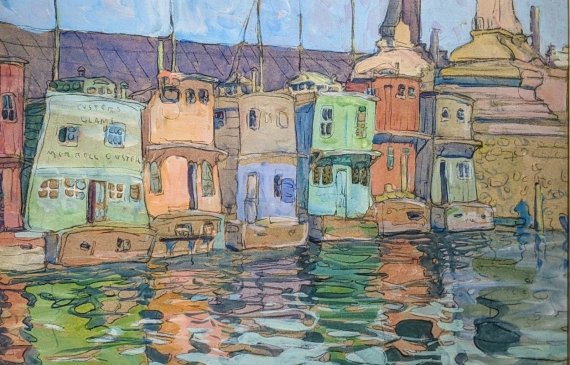
First Prize in watercolor, American Exhibition in the Girls Club of Paris, 1916
Pettingale Prize for watercolor, National Association for Women Painters and Sculptors, 1927
Fellow at the National Academy of Design
Most Outstanding Individual of the Year, American Historical Society, 1938
Jane Peterson was born in Elgin, Illinois, on November 28, 1876, the daughter of an Elgin Watch Company employee and a homemaker. She started her life as Jennie Christine but changed her name to Jane shortly after her high school graduation in 1894. Jane learned about the Pratt Institute, a fairly new technical school, at the 1893 Columbian Exposition in Chicago, where she took an aptitude test for art. She enjoyed drawing and painting but had not considered art before as a career. With a $300 loan, Jane traveled to New York after graduation and enrolled in the art department of Pratt Institute. Her art matured rapidly, and with the proceeds from sales of her artwork, she was able to pay back that $300 her first year. She completed her studies at Pratt in 1901 and pursued art until arthritis in both hands ended her ability to paint in the mid-1950s. During her lifetime, Jane Peterson was featured in more than 80 one-woman exhibitions before her death on August 14, 1965.
Jane was an art instructor at schools and academies in Elmira, New York, the Maryland Institute in Baltimore, and taught watercolor painting at the Art Students League in New York City from 914-1919. In addition, she served as Drawing Supervisor for the Boston Public Schools. By 1912, she had many rich patrons.
Jane had the good fortune to study with prominent European artists abroad, including the eminent Joaquin Sorolla (in both Madrid and New York). She was not afraid to travel alone and was especially drawn to the natural beauty of Venice, Chioggia, Italy, and the landscapes of France, Turkey, and Spain, as well as northern Africa. While in Paris, Jane attended Gertrude Stein’s Saturday evening salons and rubbed elbows with Braque, Rousseau, and even Pablo Picasso. According to Jeffery White of Elgin, Illinois, who nominated Jane Peterson for the Fox Valley Arts Hall of Fame, “she was certainly living her dream.”
A catalogue from the Art Institute of Chicago lists 87 of Jane Peterson’s oil paintings on exhibit from December 6 to 27, 1910, which were painted during her two-years of travel overseas. The internationally known writer and astronomer, Percival Lowell, sponsored Jane’s first exhibition in Paris. She also exhibited at the 1915 Pan Pacific International Exhibition in San Francisco as part of the women’s suffrage exhibit. During World War I, Jane’s war-oriented paintings were displayed, sold, or donated to promote Liberty Loans and the American Red Cross.
Jane had the good fortune to travel with Louis Comfort Tiffany and paint with John Singer Sargent, Childe Hassam, and Maurice Prendergast. She held numerous professional memberships in such groups as the Allied Artists of America, the American Watercolor Society, the National Association of Women Painters and Sculptors, the Washington Watercolor Club, the New York Society of Painters, the Audubon Artists, and the Connecticut Academy of Fine Arts.
During the 1920s, when Jane was at the height of her popularity, she married Moritz Bernard Philipp, a man almost 30 years her senior, whom she had met at the opera. Sadly, he died only 4 years later. The couple lived in a 5-story home, with a sky-lighted studio for Jane on the top floor, located on Fifth Avenue in New York City, across the street from the Metropolitan Museum of Art (Jane was married again in 1939 to a New Haven doctor, but divorced within a year).
After losing her first husband, Jane focused on painting flowers, zinnias being her favorite subject. Jeffery White noted the artist’s comment about flowers, “I paint flowers because they are my friends and I love them. They have personalities just as animals, birds and people (do), and are very sensitive to kindness, attention and to their surroundings.” Despite the versatility in the subjects she chose to paint, Jane may be best known for her paintings of flowers, because she authored an instructional book on that topic entitled Flower Painting in 1946.
Jane earned first prize in watercolor at the American Exhibition in the Girl’s Club of Paris, France, in 1916, the Noel Flagg memorial prize for best oil painting at the Connecticut Academy of Fine Arts exhibition in 1917, the Pettingale Prize for watercolor at the National Association of Women Painters and Sculptors in 1927, and first prize for best flower picture in the annual exhibition of the Florida Federation of Arts in 1937. Jane’s painting “Toilette” received rave reviews at the New York Society of Painters in 1924. By this time, she had been named a Fellow at the National Academy of Design. In 1925, the New York Times named Jane Peterson “one of the foremost women painters in New York.” In 1938, she was named the “Most Outstanding Individual of the Year” by the American Historical Society, only the second woman to be so honored.
According to her biographer, J.J. Joseph (Jane Peterson, American Painter, 1982), Jane’s oils and watercolors covered a wide range of subjects. She created colorful, post-impressionistic landscapes of Gloucester streets, the harbor on Cape Ann, palm trees along Florida’s coasts, and street scenes in Paris, Istanbul, New York, Italy, and other picturesque cities.
One of Jane’s last nationally recognized efforts occurred in 1944, when her portraits of four U.S. servicewomen – a Wac, a Wave, a Spar, and a Marine – representing each of the armed forces in which women served during World War II, raised $211,000 in War Bonds for the creation of a permanent memorial. During that period, Jane often accepted War Bonds in lieu of full payment for her artwork.
Her artwork is represented in numerous permanent collections, including the Metropolitan Museum of Art in New York City, where she was a board member, the Pennsylvania Academy of Fine Arts, and the Baltimore Museum of Fine Arts. One of Jane’s most famous pieces, “Glimpse of the Grand Canal,” is held at the Art Association of Grand Rapids, Michigan. Locally, the Sears Gallery at the Elgin Academy in Elgin, Illinois, the town where Jane began her life, has among their collection a painting entitled “A Busy Street” (gouache on paper, 17-1/2” x 23”), which was a gift donated by the artist some time before 1949. The Academy described her style as, “tapestry-like watercolors, made up of dabs of strokes in vibrant colors… place her in a movement somewhere between Impressionism and Post-Impressionism.”
Her painting, “The Pier at Rocky Point, Gloucester,” was posthumously selected for the July 4, 1980, cover of the Journal of the American Medical Association. Up until April 20, 1964, the covers of the weekly JAMA publication featured only a table of contents. With that issue began the tradition of decorating the journal covers with well-recognized and newly appreciated reproductions of great art. In the 1970s, Dr. Therese Southgate became the guardian of this tradition, believing that the covers provided doctors with a refreshing pause in their busy day. The selection of Jane’s art for the 1980 cover put her among the honored company of such renowned artists as Winslow Homer, Andrew Wyeth, Monet, Manet, Renoir, Van Gogh, and Cezanne.
Although Jane Peterson’s art brought her into the company of motion picture actors, design entrepreneurs, and European royalty, she passed away while living out her days quietly with her niece in Kansas. After her death on August 14, 1965, her estate was valued in excess of $1 million. Her art remains highly valued today. In 2012, her painting “Canal Venice” sold at auction for more than $130,000. As Jeff White so aptly emphasized, “Even in death, Jane’s dream lives on.”

